Sentiment Analysis in Tourism
VerifiedAdded on 2023/03/31
|7
|1892
|168
AI Summary
This article discusses various approaches of sentiment analysis used in the field of tourism and their impact on the industry. It explores the use of sentiment analysis in weather studies related to tourism and the opportunities for advancing its utilization. The article also examines the different method...
Read More
Contribute Materials
Your contribution can guide someone’s learning journey. Share your
documents today.
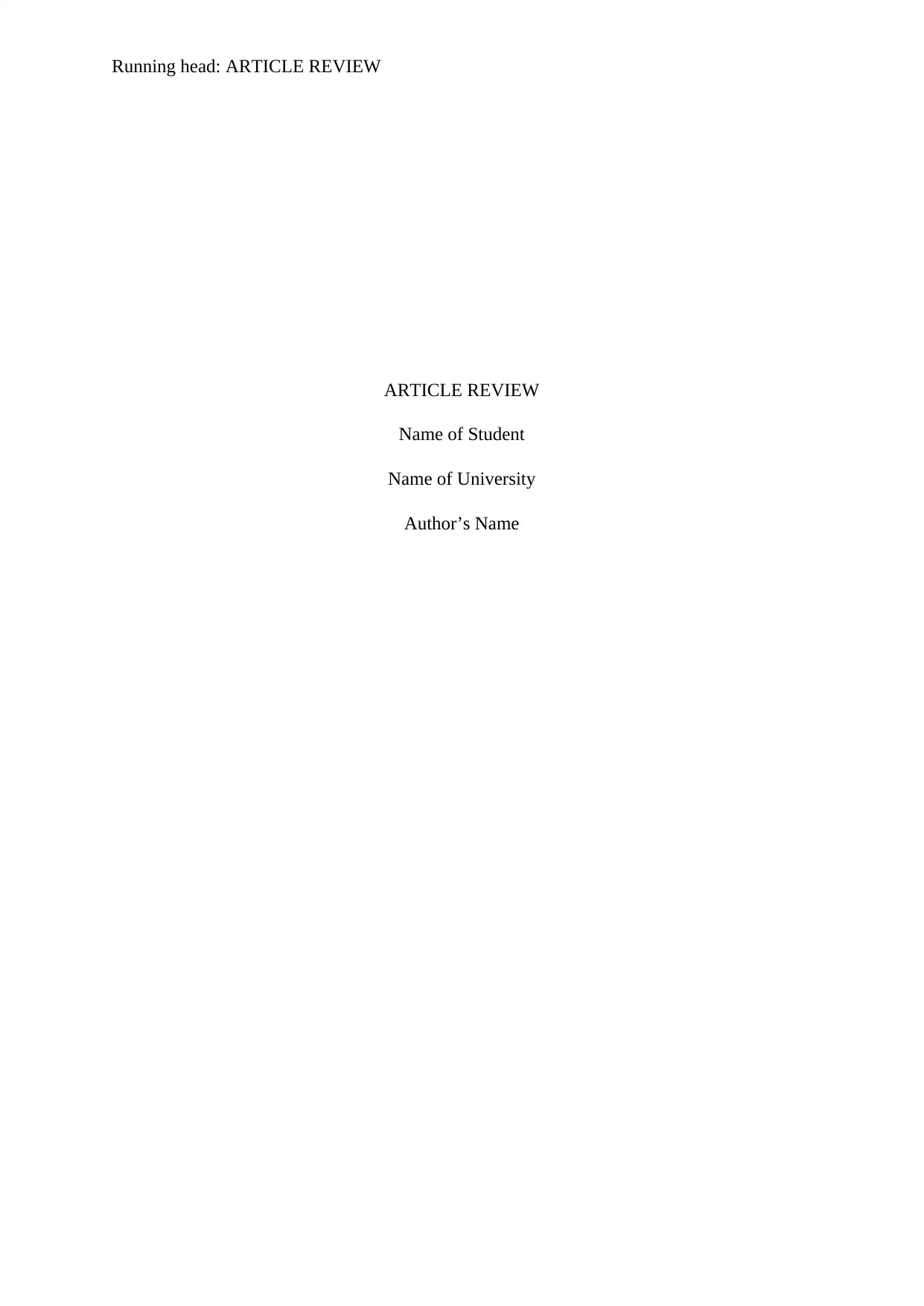
Running head: ARTICLE REVIEW
ARTICLE REVIEW
Name of Student
Name of University
Author’s Name
ARTICLE REVIEW
Name of Student
Name of University
Author’s Name
Secure Best Marks with AI Grader
Need help grading? Try our AI Grader for instant feedback on your assignments.
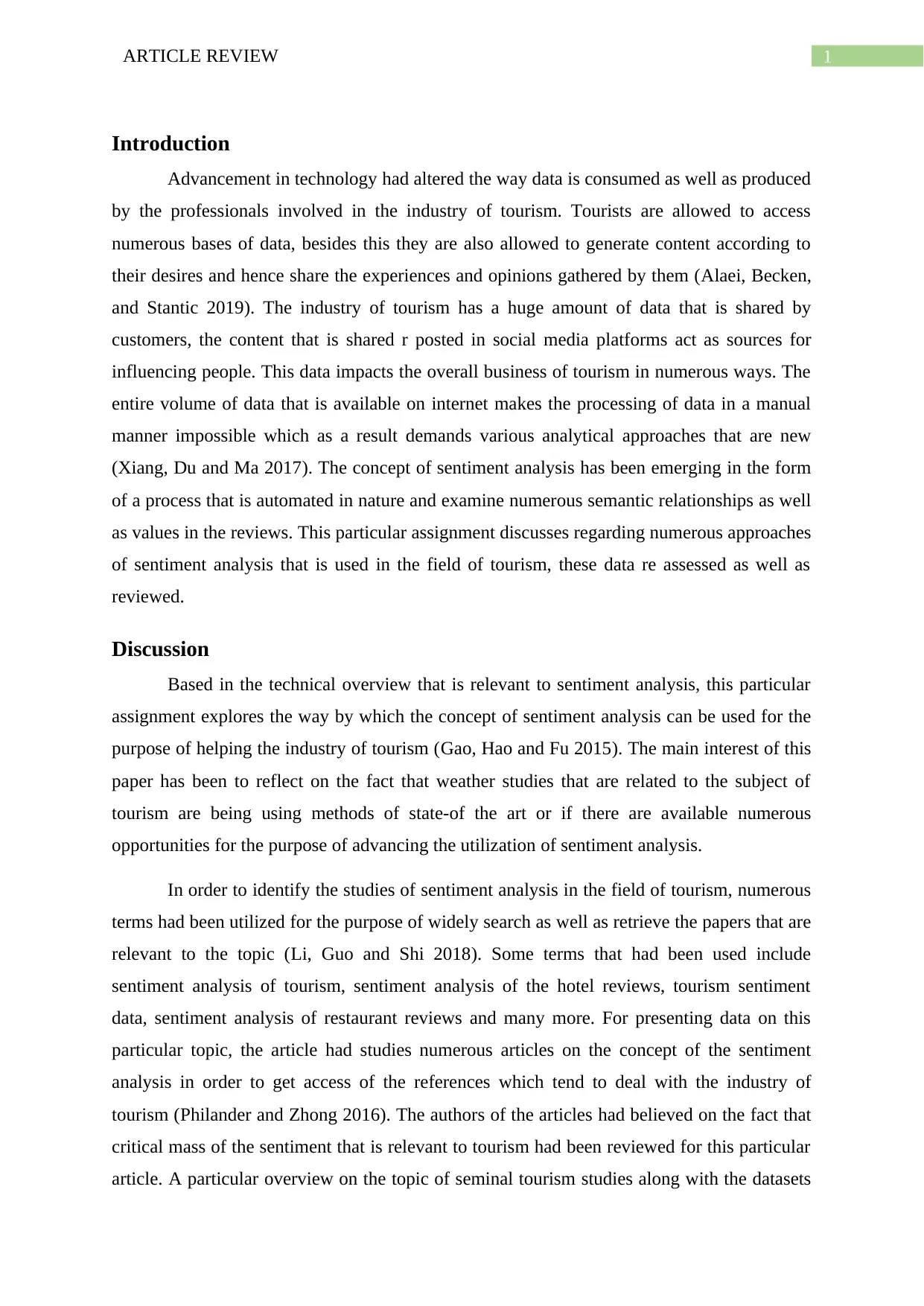
1ARTICLE REVIEW
Introduction
Advancement in technology had altered the way data is consumed as well as produced
by the professionals involved in the industry of tourism. Tourists are allowed to access
numerous bases of data, besides this they are also allowed to generate content according to
their desires and hence share the experiences and opinions gathered by them (Alaei, Becken,
and Stantic 2019). The industry of tourism has a huge amount of data that is shared by
customers, the content that is shared r posted in social media platforms act as sources for
influencing people. This data impacts the overall business of tourism in numerous ways. The
entire volume of data that is available on internet makes the processing of data in a manual
manner impossible which as a result demands various analytical approaches that are new
(Xiang, Du and Ma 2017). The concept of sentiment analysis has been emerging in the form
of a process that is automated in nature and examine numerous semantic relationships as well
as values in the reviews. This particular assignment discusses regarding numerous approaches
of sentiment analysis that is used in the field of tourism, these data re assessed as well as
reviewed.
Discussion
Based in the technical overview that is relevant to sentiment analysis, this particular
assignment explores the way by which the concept of sentiment analysis can be used for the
purpose of helping the industry of tourism (Gao, Hao and Fu 2015). The main interest of this
paper has been to reflect on the fact that weather studies that are related to the subject of
tourism are being using methods of state-of the art or if there are available numerous
opportunities for the purpose of advancing the utilization of sentiment analysis.
In order to identify the studies of sentiment analysis in the field of tourism, numerous
terms had been utilized for the purpose of widely search as well as retrieve the papers that are
relevant to the topic (Li, Guo and Shi 2018). Some terms that had been used include
sentiment analysis of tourism, sentiment analysis of the hotel reviews, tourism sentiment
data, sentiment analysis of restaurant reviews and many more. For presenting data on this
particular topic, the article had studies numerous articles on the concept of the sentiment
analysis in order to get access of the references which tend to deal with the industry of
tourism (Philander and Zhong 2016). The authors of the articles had believed on the fact that
critical mass of the sentiment that is relevant to tourism had been reviewed for this particular
article. A particular overview on the topic of seminal tourism studies along with the datasets
Introduction
Advancement in technology had altered the way data is consumed as well as produced
by the professionals involved in the industry of tourism. Tourists are allowed to access
numerous bases of data, besides this they are also allowed to generate content according to
their desires and hence share the experiences and opinions gathered by them (Alaei, Becken,
and Stantic 2019). The industry of tourism has a huge amount of data that is shared by
customers, the content that is shared r posted in social media platforms act as sources for
influencing people. This data impacts the overall business of tourism in numerous ways. The
entire volume of data that is available on internet makes the processing of data in a manual
manner impossible which as a result demands various analytical approaches that are new
(Xiang, Du and Ma 2017). The concept of sentiment analysis has been emerging in the form
of a process that is automated in nature and examine numerous semantic relationships as well
as values in the reviews. This particular assignment discusses regarding numerous approaches
of sentiment analysis that is used in the field of tourism, these data re assessed as well as
reviewed.
Discussion
Based in the technical overview that is relevant to sentiment analysis, this particular
assignment explores the way by which the concept of sentiment analysis can be used for the
purpose of helping the industry of tourism (Gao, Hao and Fu 2015). The main interest of this
paper has been to reflect on the fact that weather studies that are related to the subject of
tourism are being using methods of state-of the art or if there are available numerous
opportunities for the purpose of advancing the utilization of sentiment analysis.
In order to identify the studies of sentiment analysis in the field of tourism, numerous
terms had been utilized for the purpose of widely search as well as retrieve the papers that are
relevant to the topic (Li, Guo and Shi 2018). Some terms that had been used include
sentiment analysis of tourism, sentiment analysis of the hotel reviews, tourism sentiment
data, sentiment analysis of restaurant reviews and many more. For presenting data on this
particular topic, the article had studies numerous articles on the concept of the sentiment
analysis in order to get access of the references which tend to deal with the industry of
tourism (Philander and Zhong 2016). The authors of the articles had believed on the fact that
critical mass of the sentiment that is relevant to tourism had been reviewed for this particular
article. A particular overview on the topic of seminal tourism studies along with the datasets
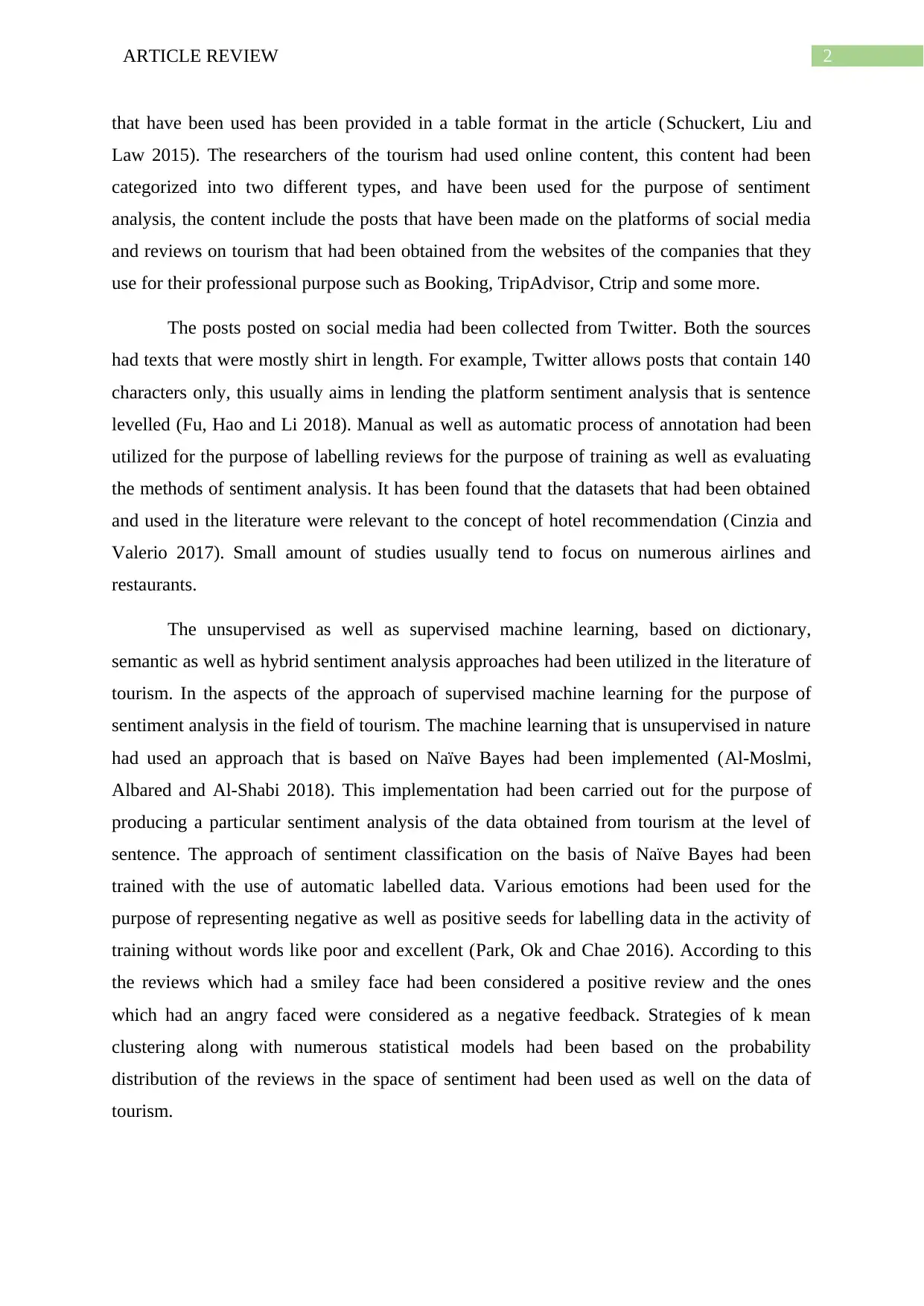
2ARTICLE REVIEW
that have been used has been provided in a table format in the article (Schuckert, Liu and
Law 2015). The researchers of the tourism had used online content, this content had been
categorized into two different types, and have been used for the purpose of sentiment
analysis, the content include the posts that have been made on the platforms of social media
and reviews on tourism that had been obtained from the websites of the companies that they
use for their professional purpose such as Booking, TripAdvisor, Ctrip and some more.
The posts posted on social media had been collected from Twitter. Both the sources
had texts that were mostly shirt in length. For example, Twitter allows posts that contain 140
characters only, this usually aims in lending the platform sentiment analysis that is sentence
levelled (Fu, Hao and Li 2018). Manual as well as automatic process of annotation had been
utilized for the purpose of labelling reviews for the purpose of training as well as evaluating
the methods of sentiment analysis. It has been found that the datasets that had been obtained
and used in the literature were relevant to the concept of hotel recommendation (Cinzia and
Valerio 2017). Small amount of studies usually tend to focus on numerous airlines and
restaurants.
The unsupervised as well as supervised machine learning, based on dictionary,
semantic as well as hybrid sentiment analysis approaches had been utilized in the literature of
tourism. In the aspects of the approach of supervised machine learning for the purpose of
sentiment analysis in the field of tourism. The machine learning that is unsupervised in nature
had used an approach that is based on Naïve Bayes had been implemented (Al-Moslmi,
Albared and Al-Shabi 2018). This implementation had been carried out for the purpose of
producing a particular sentiment analysis of the data obtained from tourism at the level of
sentence. The approach of sentiment classification on the basis of Naïve Bayes had been
trained with the use of automatic labelled data. Various emotions had been used for the
purpose of representing negative as well as positive seeds for labelling data in the activity of
training without words like poor and excellent (Park, Ok and Chae 2016). According to this
the reviews which had a smiley face had been considered a positive review and the ones
which had an angry faced were considered as a negative feedback. Strategies of k mean
clustering along with numerous statistical models had been based on the probability
distribution of the reviews in the space of sentiment had been used as well on the data of
tourism.
that have been used has been provided in a table format in the article (Schuckert, Liu and
Law 2015). The researchers of the tourism had used online content, this content had been
categorized into two different types, and have been used for the purpose of sentiment
analysis, the content include the posts that have been made on the platforms of social media
and reviews on tourism that had been obtained from the websites of the companies that they
use for their professional purpose such as Booking, TripAdvisor, Ctrip and some more.
The posts posted on social media had been collected from Twitter. Both the sources
had texts that were mostly shirt in length. For example, Twitter allows posts that contain 140
characters only, this usually aims in lending the platform sentiment analysis that is sentence
levelled (Fu, Hao and Li 2018). Manual as well as automatic process of annotation had been
utilized for the purpose of labelling reviews for the purpose of training as well as evaluating
the methods of sentiment analysis. It has been found that the datasets that had been obtained
and used in the literature were relevant to the concept of hotel recommendation (Cinzia and
Valerio 2017). Small amount of studies usually tend to focus on numerous airlines and
restaurants.
The unsupervised as well as supervised machine learning, based on dictionary,
semantic as well as hybrid sentiment analysis approaches had been utilized in the literature of
tourism. In the aspects of the approach of supervised machine learning for the purpose of
sentiment analysis in the field of tourism. The machine learning that is unsupervised in nature
had used an approach that is based on Naïve Bayes had been implemented (Al-Moslmi,
Albared and Al-Shabi 2018). This implementation had been carried out for the purpose of
producing a particular sentiment analysis of the data obtained from tourism at the level of
sentence. The approach of sentiment classification on the basis of Naïve Bayes had been
trained with the use of automatic labelled data. Various emotions had been used for the
purpose of representing negative as well as positive seeds for labelling data in the activity of
training without words like poor and excellent (Park, Ok and Chae 2016). According to this
the reviews which had a smiley face had been considered a positive review and the ones
which had an angry faced were considered as a negative feedback. Strategies of k mean
clustering along with numerous statistical models had been based on the probability
distribution of the reviews in the space of sentiment had been used as well on the data of
tourism.
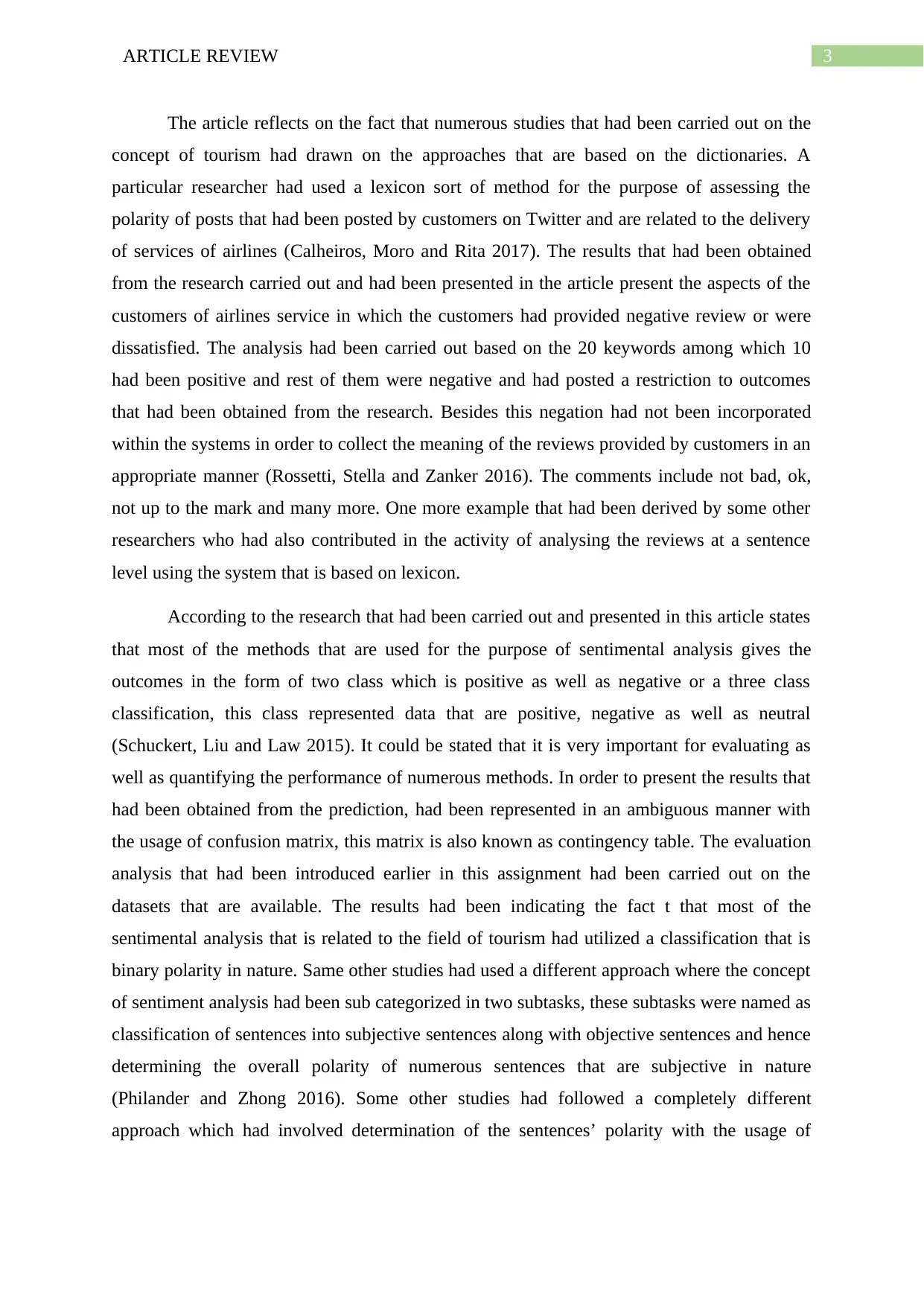
3ARTICLE REVIEW
The article reflects on the fact that numerous studies that had been carried out on the
concept of tourism had drawn on the approaches that are based on the dictionaries. A
particular researcher had used a lexicon sort of method for the purpose of assessing the
polarity of posts that had been posted by customers on Twitter and are related to the delivery
of services of airlines (Calheiros, Moro and Rita 2017). The results that had been obtained
from the research carried out and had been presented in the article present the aspects of the
customers of airlines service in which the customers had provided negative review or were
dissatisfied. The analysis had been carried out based on the 20 keywords among which 10
had been positive and rest of them were negative and had posted a restriction to outcomes
that had been obtained from the research. Besides this negation had not been incorporated
within the systems in order to collect the meaning of the reviews provided by customers in an
appropriate manner (Rossetti, Stella and Zanker 2016). The comments include not bad, ok,
not up to the mark and many more. One more example that had been derived by some other
researchers who had also contributed in the activity of analysing the reviews at a sentence
level using the system that is based on lexicon.
According to the research that had been carried out and presented in this article states
that most of the methods that are used for the purpose of sentimental analysis gives the
outcomes in the form of two class which is positive as well as negative or a three class
classification, this class represented data that are positive, negative as well as neutral
(Schuckert, Liu and Law 2015). It could be stated that it is very important for evaluating as
well as quantifying the performance of numerous methods. In order to present the results that
had been obtained from the prediction, had been represented in an ambiguous manner with
the usage of confusion matrix, this matrix is also known as contingency table. The evaluation
analysis that had been introduced earlier in this assignment had been carried out on the
datasets that are available. The results had been indicating the fact t that most of the
sentimental analysis that is related to the field of tourism had utilized a classification that is
binary polarity in nature. Same other studies had used a different approach where the concept
of sentiment analysis had been sub categorized in two subtasks, these subtasks were named as
classification of sentences into subjective sentences along with objective sentences and hence
determining the overall polarity of numerous sentences that are subjective in nature
(Philander and Zhong 2016). Some other studies had followed a completely different
approach which had involved determination of the sentences’ polarity with the usage of
The article reflects on the fact that numerous studies that had been carried out on the
concept of tourism had drawn on the approaches that are based on the dictionaries. A
particular researcher had used a lexicon sort of method for the purpose of assessing the
polarity of posts that had been posted by customers on Twitter and are related to the delivery
of services of airlines (Calheiros, Moro and Rita 2017). The results that had been obtained
from the research carried out and had been presented in the article present the aspects of the
customers of airlines service in which the customers had provided negative review or were
dissatisfied. The analysis had been carried out based on the 20 keywords among which 10
had been positive and rest of them were negative and had posted a restriction to outcomes
that had been obtained from the research. Besides this negation had not been incorporated
within the systems in order to collect the meaning of the reviews provided by customers in an
appropriate manner (Rossetti, Stella and Zanker 2016). The comments include not bad, ok,
not up to the mark and many more. One more example that had been derived by some other
researchers who had also contributed in the activity of analysing the reviews at a sentence
level using the system that is based on lexicon.
According to the research that had been carried out and presented in this article states
that most of the methods that are used for the purpose of sentimental analysis gives the
outcomes in the form of two class which is positive as well as negative or a three class
classification, this class represented data that are positive, negative as well as neutral
(Schuckert, Liu and Law 2015). It could be stated that it is very important for evaluating as
well as quantifying the performance of numerous methods. In order to present the results that
had been obtained from the prediction, had been represented in an ambiguous manner with
the usage of confusion matrix, this matrix is also known as contingency table. The evaluation
analysis that had been introduced earlier in this assignment had been carried out on the
datasets that are available. The results had been indicating the fact t that most of the
sentimental analysis that is related to the field of tourism had utilized a classification that is
binary polarity in nature. Same other studies had used a different approach where the concept
of sentiment analysis had been sub categorized in two subtasks, these subtasks were named as
classification of sentences into subjective sentences along with objective sentences and hence
determining the overall polarity of numerous sentences that are subjective in nature
(Philander and Zhong 2016). Some other studies had followed a completely different
approach which had involved determination of the sentences’ polarity with the usage of
Secure Best Marks with AI Grader
Need help grading? Try our AI Grader for instant feedback on your assignments.
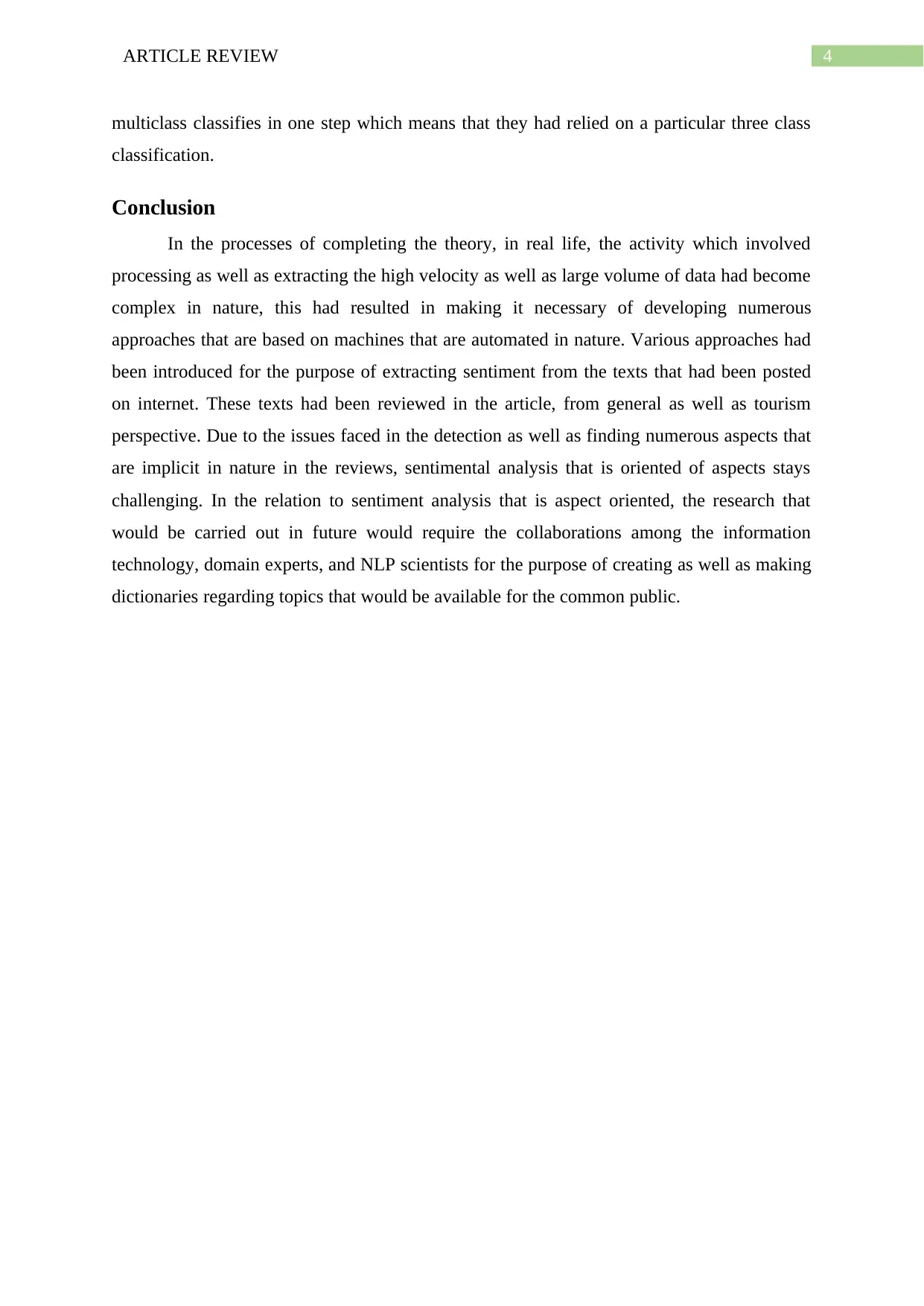
4ARTICLE REVIEW
multiclass classifies in one step which means that they had relied on a particular three class
classification.
Conclusion
In the processes of completing the theory, in real life, the activity which involved
processing as well as extracting the high velocity as well as large volume of data had become
complex in nature, this had resulted in making it necessary of developing numerous
approaches that are based on machines that are automated in nature. Various approaches had
been introduced for the purpose of extracting sentiment from the texts that had been posted
on internet. These texts had been reviewed in the article, from general as well as tourism
perspective. Due to the issues faced in the detection as well as finding numerous aspects that
are implicit in nature in the reviews, sentimental analysis that is oriented of aspects stays
challenging. In the relation to sentiment analysis that is aspect oriented, the research that
would be carried out in future would require the collaborations among the information
technology, domain experts, and NLP scientists for the purpose of creating as well as making
dictionaries regarding topics that would be available for the common public.
multiclass classifies in one step which means that they had relied on a particular three class
classification.
Conclusion
In the processes of completing the theory, in real life, the activity which involved
processing as well as extracting the high velocity as well as large volume of data had become
complex in nature, this had resulted in making it necessary of developing numerous
approaches that are based on machines that are automated in nature. Various approaches had
been introduced for the purpose of extracting sentiment from the texts that had been posted
on internet. These texts had been reviewed in the article, from general as well as tourism
perspective. Due to the issues faced in the detection as well as finding numerous aspects that
are implicit in nature in the reviews, sentimental analysis that is oriented of aspects stays
challenging. In the relation to sentiment analysis that is aspect oriented, the research that
would be carried out in future would require the collaborations among the information
technology, domain experts, and NLP scientists for the purpose of creating as well as making
dictionaries regarding topics that would be available for the common public.
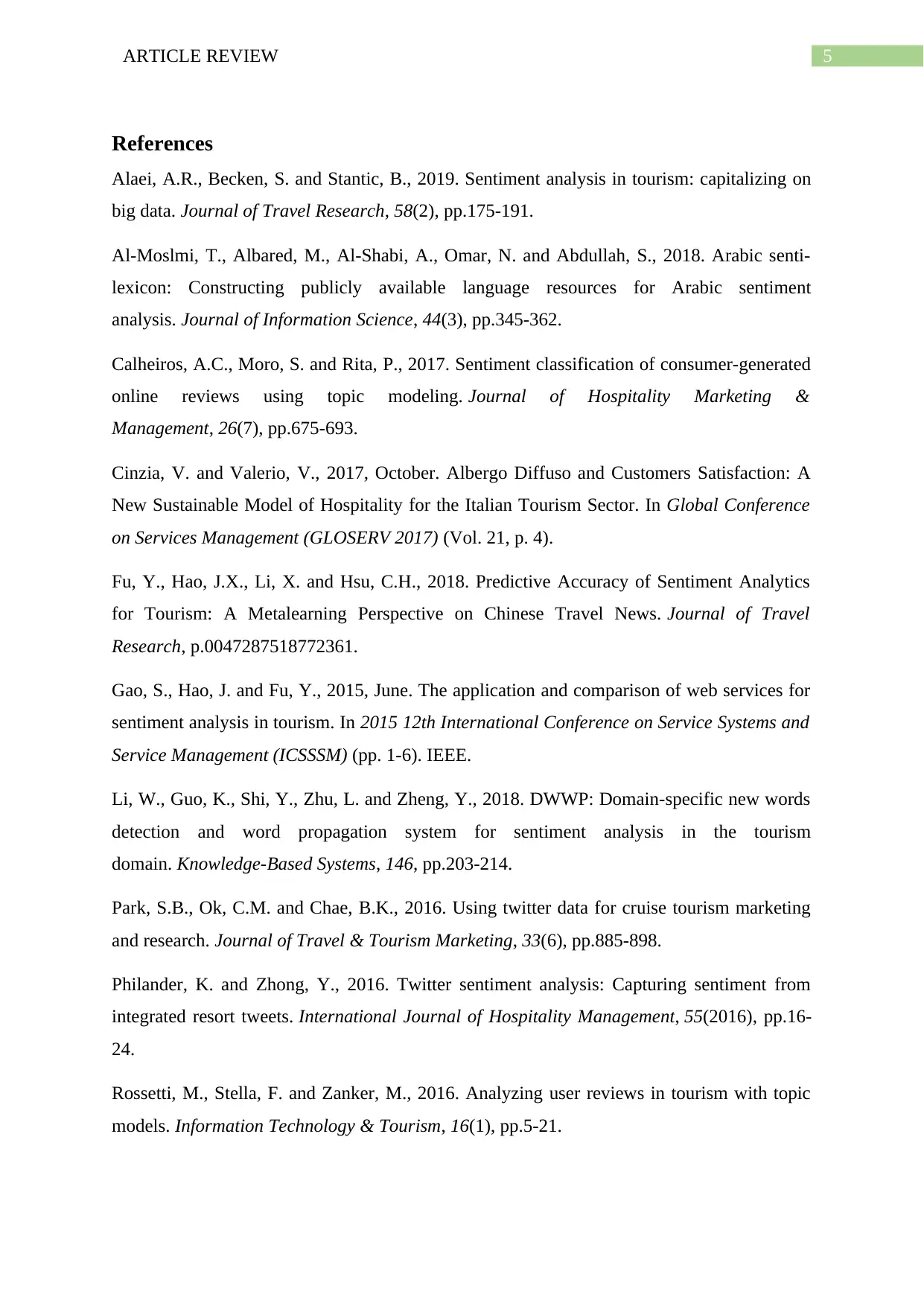
5ARTICLE REVIEW
References
Alaei, A.R., Becken, S. and Stantic, B., 2019. Sentiment analysis in tourism: capitalizing on
big data. Journal of Travel Research, 58(2), pp.175-191.
Al-Moslmi, T., Albared, M., Al-Shabi, A., Omar, N. and Abdullah, S., 2018. Arabic senti-
lexicon: Constructing publicly available language resources for Arabic sentiment
analysis. Journal of Information Science, 44(3), pp.345-362.
Calheiros, A.C., Moro, S. and Rita, P., 2017. Sentiment classification of consumer-generated
online reviews using topic modeling. Journal of Hospitality Marketing &
Management, 26(7), pp.675-693.
Cinzia, V. and Valerio, V., 2017, October. Albergo Diffuso and Customers Satisfaction: A
New Sustainable Model of Hospitality for the Italian Tourism Sector. In Global Conference
on Services Management (GLOSERV 2017) (Vol. 21, p. 4).
Fu, Y., Hao, J.X., Li, X. and Hsu, C.H., 2018. Predictive Accuracy of Sentiment Analytics
for Tourism: A Metalearning Perspective on Chinese Travel News. Journal of Travel
Research, p.0047287518772361.
Gao, S., Hao, J. and Fu, Y., 2015, June. The application and comparison of web services for
sentiment analysis in tourism. In 2015 12th International Conference on Service Systems and
Service Management (ICSSSM) (pp. 1-6). IEEE.
Li, W., Guo, K., Shi, Y., Zhu, L. and Zheng, Y., 2018. DWWP: Domain-specific new words
detection and word propagation system for sentiment analysis in the tourism
domain. Knowledge-Based Systems, 146, pp.203-214.
Park, S.B., Ok, C.M. and Chae, B.K., 2016. Using twitter data for cruise tourism marketing
and research. Journal of Travel & Tourism Marketing, 33(6), pp.885-898.
Philander, K. and Zhong, Y., 2016. Twitter sentiment analysis: Capturing sentiment from
integrated resort tweets. International Journal of Hospitality Management, 55(2016), pp.16-
24.
Rossetti, M., Stella, F. and Zanker, M., 2016. Analyzing user reviews in tourism with topic
models. Information Technology & Tourism, 16(1), pp.5-21.
References
Alaei, A.R., Becken, S. and Stantic, B., 2019. Sentiment analysis in tourism: capitalizing on
big data. Journal of Travel Research, 58(2), pp.175-191.
Al-Moslmi, T., Albared, M., Al-Shabi, A., Omar, N. and Abdullah, S., 2018. Arabic senti-
lexicon: Constructing publicly available language resources for Arabic sentiment
analysis. Journal of Information Science, 44(3), pp.345-362.
Calheiros, A.C., Moro, S. and Rita, P., 2017. Sentiment classification of consumer-generated
online reviews using topic modeling. Journal of Hospitality Marketing &
Management, 26(7), pp.675-693.
Cinzia, V. and Valerio, V., 2017, October. Albergo Diffuso and Customers Satisfaction: A
New Sustainable Model of Hospitality for the Italian Tourism Sector. In Global Conference
on Services Management (GLOSERV 2017) (Vol. 21, p. 4).
Fu, Y., Hao, J.X., Li, X. and Hsu, C.H., 2018. Predictive Accuracy of Sentiment Analytics
for Tourism: A Metalearning Perspective on Chinese Travel News. Journal of Travel
Research, p.0047287518772361.
Gao, S., Hao, J. and Fu, Y., 2015, June. The application and comparison of web services for
sentiment analysis in tourism. In 2015 12th International Conference on Service Systems and
Service Management (ICSSSM) (pp. 1-6). IEEE.
Li, W., Guo, K., Shi, Y., Zhu, L. and Zheng, Y., 2018. DWWP: Domain-specific new words
detection and word propagation system for sentiment analysis in the tourism
domain. Knowledge-Based Systems, 146, pp.203-214.
Park, S.B., Ok, C.M. and Chae, B.K., 2016. Using twitter data for cruise tourism marketing
and research. Journal of Travel & Tourism Marketing, 33(6), pp.885-898.
Philander, K. and Zhong, Y., 2016. Twitter sentiment analysis: Capturing sentiment from
integrated resort tweets. International Journal of Hospitality Management, 55(2016), pp.16-
24.
Rossetti, M., Stella, F. and Zanker, M., 2016. Analyzing user reviews in tourism with topic
models. Information Technology & Tourism, 16(1), pp.5-21.
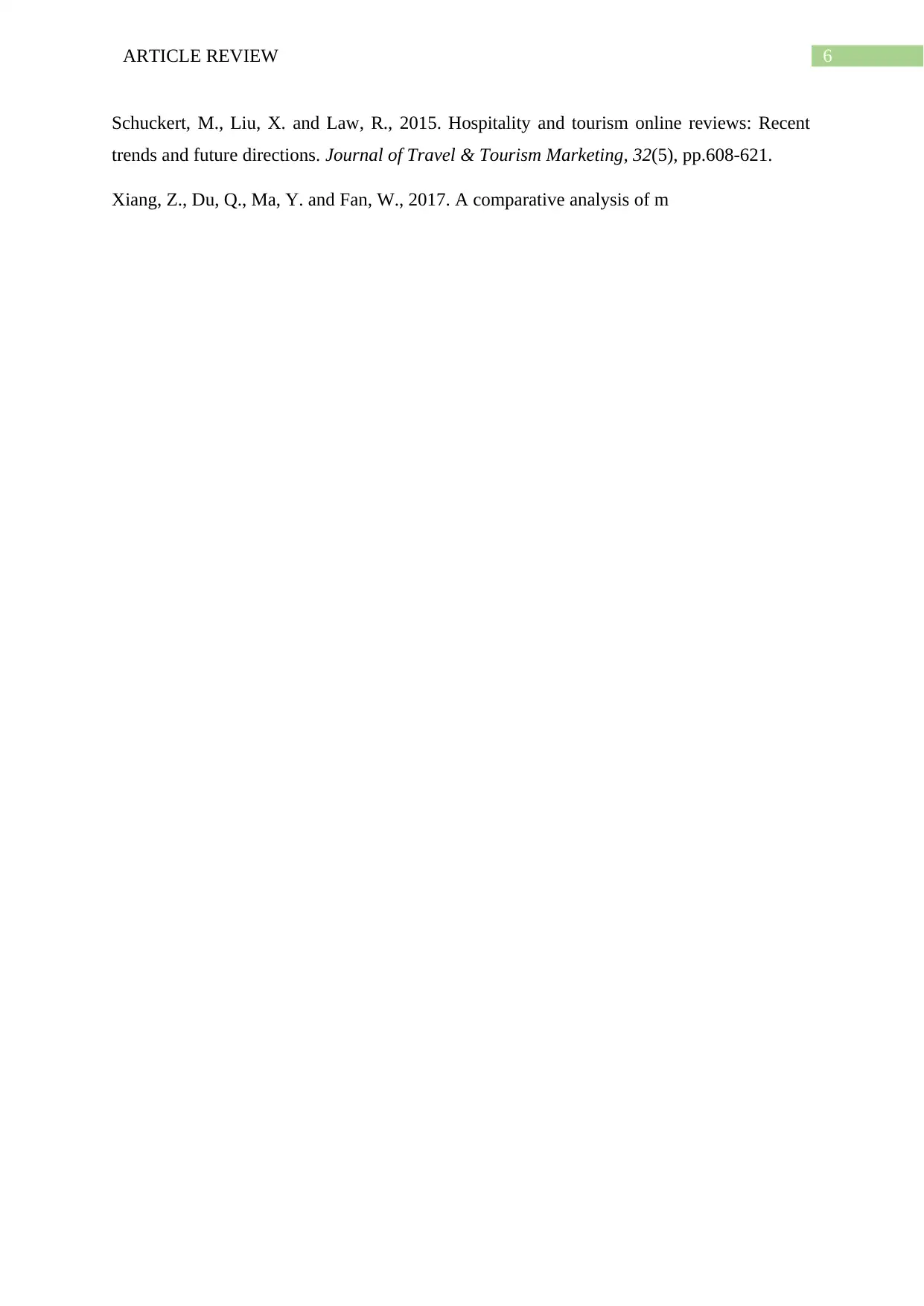
6ARTICLE REVIEW
Schuckert, M., Liu, X. and Law, R., 2015. Hospitality and tourism online reviews: Recent
trends and future directions. Journal of Travel & Tourism Marketing, 32(5), pp.608-621.
Xiang, Z., Du, Q., Ma, Y. and Fan, W., 2017. A comparative analysis of m
Schuckert, M., Liu, X. and Law, R., 2015. Hospitality and tourism online reviews: Recent
trends and future directions. Journal of Travel & Tourism Marketing, 32(5), pp.608-621.
Xiang, Z., Du, Q., Ma, Y. and Fan, W., 2017. A comparative analysis of m
1 out of 7
Related Documents
Your All-in-One AI-Powered Toolkit for Academic Success.
+13062052269
info@desklib.com
Available 24*7 on WhatsApp / Email
![[object Object]](/_next/static/media/star-bottom.7253800d.svg)
Unlock your academic potential
© 2024 | Zucol Services PVT LTD | All rights reserved.





